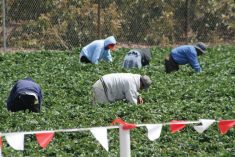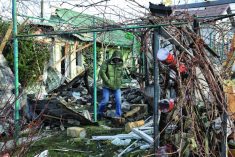As people try to reduce their use of plastic products, there is a need for items created from environmentally friendly products.
Researchers at the University of Alberta may have come up with part of the solution — cling wrap made from canola straw.
The product is the only one of its kind in the world, said Marleny Saldaña, an expert in “bioengineering processing” and an associate professor at the university’s faculty of agriculture, life and environmental sciences.
“The aim is to move towards biodegradable, decomposable plastics,” said Saldaña. “We can come up with something that is biodegradable and can replace plastics using biopolymers.”
And that’s something that needs to happen, she said.
“We know that plastic is a big industry. We put plastic in many, many things. It’s not sustainable. We know that these plastics will take so many years to decompose.”
Straw makes up about two-fifths of the biomass in a canola crop, but it’s a waste product and is typically left on the field as a residue.
“People don’t take advantage of the value that it has,” she said.

To make the cling wrap, members of Saldaña’s research group take the canola straw and turn it into meal. This breaks the straw into cellulose and lignins. Both have strong binding properties, and that make them valuable components.
“Cellulose is a big commodity,” said Saldaña. “The price for cellulose is very good.”
The researchers use a process that breaks the straw into tiny cellulose nanofibres using “very green” technological processes, she said. They began researching canola cling wrap back in 2017, after successfully making cling wrap from potato peels and culled potatoes in 2014. And while process for making potato peel wrap was promising enough to patent, it was expensive.
“There is possibly some application for it. But we were thinking we wanted to have something with antimicrobial activity,” she said.
Read Also

Farming Smarter receives financial boost from Alberta government for potato research
Farming Smarter near Lethbridge got a boost to its research equipment, thanks to the Alberta government’s increase in funding for research associations.
The group also investigated cling wrap from starch extracted from cassava (a root vegetable widely consumed in tropical countries), but it lacked the necessary strength. They then took the cellulose nanofibres from canola, and added it to cassava starch to produce a product that was 12 times stronger.
There are a number of different applications for the cling wrap, including an alternative to plastic bags, said Saldaña. They see the possibility for the canola cling wrap or products like it to be used for pharmaceutical consumption or biomedical use.
“Most applications are food grade,” she said. “We have some other ideas, but are exploring food.”
All of these uses could spur the creation of a canola straw-processing sector on the Prairies, Saldaña told the university’s online magazine.
“We have the capacity here for processing canola in Canada to create more industry and high-value products like cellulose nanofibres from canola straw,” she said.
And there would be no shortage of supply.
“We have a lot of straw for us to process and make this nice value-added product,” she said.
Her research group, which receives funding from the Natural Sciences and Engineering Research Council of Canada, is currently testing the biodegradability of the canola cling wrap.
The product has also made Saldaña an in-demand speaker, and she will soon be heading to conferences in Brazil, Australia and Mexico.
















